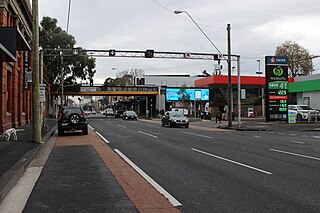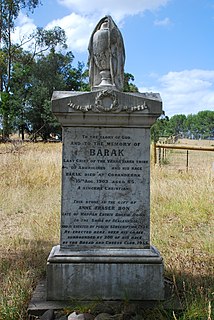
The history of Melbourne details the city's growth from a fledgling settlement into a modern commercial and financial centre as Australia's second largest city, Melbourne, in the state of Victoria.

The Wurundjeri are an Aboriginal Australian nation of the Woiwurrung language group, in the Kulin nation. They occupied the Birrarung Valley before British settlement of the area, around the present location of Melbourne, and were called the Yarra tribe by the settlers. The Wurundjeri are one of several sub-groups or clans of Woiwurrung people who traditionally occupied some of the territory now the site of the city of Melbourne. There were two separate clan groups, Wurundjeri-balluk and Wurundjeri-willam.

Healesville is a town in Victoria, Australia, 52 km north-east from Melbourne's central business district. Its local government area is the Shire of Yarra Ranges. At the 2016 Census, Healesville had a population of 7,461. The median age was 44 years.

Abbotsford is an inner-city suburb of Melbourne, Australia, 2 kilometres (1.2 mi) north-east of Melbourne's Central Business District. Its local government area is the City of Yarra. At the 2016 census, Abbotsford had a population of 8,184.

The Kulin nation is an alliance of five Indigenous Australian nations in south central Victoria, Australia. Their collective territory extends around Port Phillip and Western Port, up into the Great Dividing Range and the Loddon and Goulburn River valleys.

William Barak, was a traditional ngurungaeta (elder) of the Wurundjeri-willam clan, first inhabitants of present-day Melbourne, Australia. He became an influential spokesman for Aboriginal social justice and an important informant on Wurundjeri cultural lore.
The Boon wurrung, are an Aboriginal people of the Kulin nation, who occupy from Werribee River to Wilsons Prom, Victoria, Australia, including part of what is now the city and suburbs of Melbourne. Before British colonisation, they lived as all people of the Kulin nation lived, sustainably on the land, for tens of thousands of years. They were called the Western Port or Port Philip tribe by the early settlers, and were in alliance with other tribes in the Kulin nation, having particularly strong ties to the Wurundjeri people.

The Taungurong people, also known as the Daung Wurrung, were thirteen clans who spoke the Daungwurrung language and were part of the Kulin alliance of indigenous Australians. They lived to the north of, and were closely associated with, the Woiwurrung speaking Wurundjeri people. Their territory is to the north of the Great Dividing Range in the watersheds of the Broken, Delatite, Coliban, Goulburn and Campaspe Rivers. They were also known by white settlers as the Devil's River Tribe or Goulburn River Tribe.

Coranderrk was an Aboriginal reserve run by the Victorian government between 1863 and 1924, located around 50 kilometres (31 mi) north-east of Melbourne. The residents were mainly of the Woiwurrung, Bunurong and Taungurong peoples, and the first inhabitants chose the site of the reserve.
Ngurungaeta is a Woi-Wurrung word often said to mean "head man" or "tribal leader", used by clans of the Woi-Wurrung tribes and Taung Wurrung Ngurai-illum Wurrung. Ngurungaeta held the same tribal standing as an Arweet of the Bunurong and Wathaurong people. The current Ngurungaeta is Murrundindi. The term became of particular importance as an identifier of senior men prepared to accept Anglo control in the latter part of the 19th century. It is unlikely that the term was used to express genuine recognition of senior members of traditional groups in the Melbourne area after the 1840s, following the death of Billibellary c. 1846.
Land councils, also known as Aboriginal land councils, or land and sea councils, are Australian community organisations, generally organised by region, that are commonly formed to represent the Indigenous Australians who occupied their particular region before the arrival of European settlers. They have historically advocated for recognition of traditional land rights, and also for the rights of Indigenous people in other areas such as equal wages and adequate housing. Land councils are self-supporting, and not funded by state or federal taxes.
James Wandin, also known as Jim, Jimmy, or Juby, was the ngurungaeta of the Wurundjeri till his death in February 2006. He was the first Australian rules footballer of Aboriginal descent to play with St Kilda Football Club in 1952–1953.
Billibellary was a song maker and influential ngurungaeta of the Wurundjeri-willam clan during the early years of European settlement of Melbourne. He was known by various names including Billi-billeri, Billibellary, Jika Jika, Jacky Jacky and Jaga Jaga. He was an astute and diplomatic leader, described as powerfully built with an influence and reputation that extended well beyond his clan.

The Kulin languages are a group of closely related languages of the Kulin people, part of the Kulinic branch of Pama–Nyungan.

Aboriginal Victorians, the Aboriginal Australians of Victoria, Australia, occupied the land for tens of thousands of years prior to European settlement. Aboriginal people have lived a semi-nomadic existence of fishing, hunting and gathering, and farming eels in Victoria for at least 40,000 years.
Ian D. Clark is an academic historian and Toponymist whose primary work has focused on Victorian Aboriginal history, aboriginal toponymy and the frontier conflict between Indigenous Australians and immigrant settlers during the European settlement of Victoria, Australia.

The Mount William stone axe quarry is an Aboriginal Australian archaeological site in Central Victoria, Australia. It is located 9 kilometres (5.6 mi) northeast of Lancefield, off Powells Track, 10 kilometres (6.2 mi) north of Romsey and 78 kilometres (48 mi) from Melbourne. Known as Wil-im-ee Moor-ring, meaning "axe place" in the Woiwurrung language, the greenstone quarry was an important source of raw material for the manufacture of greenstone ground-edge axes, which were traded over a wide area of south-east Australia.

The Woiwurrung, also spelt Woi Wurrung, Woiwurrong, Woiworung, Wuywurung, are an Aboriginal Australian people of the Woiwurrung language group, in the Kulin alliance.

A Registered Aboriginal Party (RAP) is a recognised representative body of an Aboriginal Australian people per the Aboriginal Heritage Act 2006 (Vic.), whose function is to protect and manage the Aboriginal cultural heritage in the state of Victoria in Australia.
The Bunurong Land Council Aboriginal Corporation is a Registered Aboriginal Party and incorporated association representing the Bunurong community in the state of Victoria, Australia, particularly in matters relating to the Victorian Aboriginal Heritage Act 2006.










